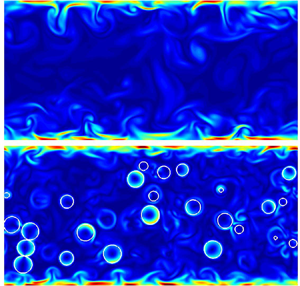Article contents
A direct numerical simulation analysis of coherent structures in bubble-laden channel flows
Published online by Cambridge University Press: 04 November 2020
Abstract

To investigate the coherent structures in turbulent wall-bounded bubbly flows, a local flow topology analysis has been performed in this work. Using the invariants of the velocity-gradient tensor, all possible small-scale flow structures can be categorized into two nodal and two focal topologies for incompressible flows. The analysed direct numerical simulation database of freely moving and deforming bubble swarms is based on a multi-marker geometrical volume-of-fluid method. It appears that bubbles are acting as mixing elements and fragmenting the large topology structures. Since the behaviour in both phases is quite different, key quantities were evaluated in a conditional manner, i.e. separately for the gaseous dispersed phase and the liquid carrier phase. Several similarities with an analytical solution for laminar creeping flows have been observed although the investigated channel flow is turbulent. It has been concluded that the inclusion of bubbles results in a partial shift from focal to nodal flow character whereas the share of stable and unstable flow types remains fairly constant at approximately 50 % in both phases. No clear analogy can be discerned in terms of the global effects of bubble inclusion and wall confinement on flow topologies. At least with respect to flow topologies, regions in the vicinity of the interface show a clearly different behaviour depending on the phase. The size distribution of coherent structures in the bubble-laden channel flow has also been analysed. The measured flow topology size spectrum in the liquid phase can be approximated by a simple model with reasonable accuracy.
- Type
- JFM Papers
- Information
- Copyright
- © The Author(s), 2020. Published by Cambridge University Press
References
REFERENCES
- 15
- Cited by



